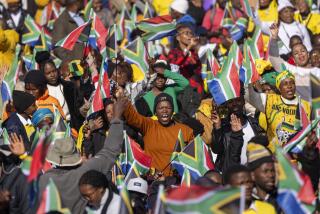Bitter Harvest in Apartheid ‘Homelands’
- Share via
BLOEDFONTEIN, South Africa — This is a tale as old as the hills: about men who bought a piece of land, paid for it with years of sweat and toil, and then lose it because the deed is not “legal.” It is a South African story that curls and twists like bitter smoke around the people of this remote black farming community 70 miles northeast of Pretoria.
These people trace their history back to 1917 when their Ndebele forebears went to work for the white farmer who owned the land. It was a fine farm of roughly 15,000 acres, with rich level soil and enough natural grazing for cattle. So much did these people cherish the land that they decided to buy it. It took them nine years to scrape together enough from the sale of their seeds, grain and livestock. Today the old men or their children show you the receipts; tattered scraps preserved for more than half a century noting that William Lehelo paid $24 or Isaac Shigwane contributed “three head of cattle.”
It wasn’t easy. Once, a tribesman absconded with the funds, and they had to start anew, but by 1929 they had pieced together enough to take ownership. One problem remained: The white man’s law required that a chief sign ownership on behalf of the community. The Bloedfontein people had no chief, so they sought the assistance of a neighboring chief from a tribe not related to the Ndebele, which is why the title to Bloedfontein is really in the name of an outsider--Robert Moepi.
But legal technicalities did not concern these resolute people. They prospered and plowed their money back into the farm, into building brick houses, more wells, livestock and better crops. In 1947 they bought an adjoining property, Geweerfontein. By this time Robert Moepi’s son, Patrick, was the neighboring chief, and the Bloedfontein people gave him the money and asked him to sign the deed on their behalf.
Whether he did or not, nobody at Bloedfontein or Geweerfontein knows, because Moepi never actually showed them the receipt; he just waved a piece of paper at a meeting and said: “Here it is, here is the deed.” Nobody challenged the Ndebele people’s right to the land, and life went its tranquil course.
Then the Pretoria government, imbued with the grand vision of apartheid, came up with its Bantustan, or homeland, policy. It decreed that the scattered Ndebele people must be lumped together into a “homeland” to be called KwaNdebele. This policy led to forcible resettlement of millions of blacks. Because the Moepi clan had signed ownership of Bloedfontein and Geweerfontein, and Moepi was a Tswana, the land was earmarked for incorporation into another homeland--Bophuthatswana, to which Moepi’s people belonged. This would have meant that the Ndebele farmers must leave their land and find new pastures in KwaNdebele where the government said they belonged.
But in 1977 the elders took the matter to court and won their exclusion from Bophuthatswana, which was then becoming an independent state--an independence recognized only by Pretoria. So the people were allowed to remain on their farms, and the government, for the sake of ideological neatness, placed them under the jurisdiction of the KwaNdebele homeland. The people didn’t mind, because the homeland was not independent, and they remained citizens of greater South Africa.
Then a few months ago, they read in the newspapers that the government was planning to make KwaNdebele “independent,” which would mean that some pieces of land must be added, others taken away.
Bloemfontein and Geweerfontein must go to Bophuthatswana, and the people--about 10,000--must move to new land inside the newly defined KwaNdebele. They were certain that there must have been some mistake.
Headman Ben Tema voiced his people’s outrage: “We want nothing to do with the Bantustans. What have these homelands ever done for us, for all the taxes we have paid them over the years? Nothing! We will fight this thing.”
Tema wrote to the cabinet minister in charge of black affairs--the man who a year ago announced a moratorium on forced removals, but who now admits that more than 60,000 people have since been “assisted” in moves to the homelands. “For your information,” Tema wrote, “Bloedfontein and Geweerfontein were not bought at the time of apartheid.”
The minister’s deputy replied: “The fate of the farms has been determined by an agreement between the South African and KwaNdebele governments (and) can unfortunately not be reconsidered.”
The Ndebele then turned to a group of white social workers known as the Black Sash for help, and they hired a lawyer. His letters to Pretoria are met with stony silence.
As a last resort the Ndebele turned to the press, meeting under an old thorn tree in the school yard. The women had donned colorful beaded dresses and, to the beat of cowhide drums, danced their distress. Gray-haired men in their Sunday best puffed sagely at their pipes, or rubbed thoughtfully at the carved handles of their walking sticks.
“You people,” said one old man with a bow tie and marbled waistcoat to the reporter, “you are our last hope.”
“I fought against Germany in World War II,” said another, his eyes flashing with pride. “I did so for the sake of my land, and I (am) prepared to fight for it again.”
Yet, for once, it was not the elders who dominated the proceedings. In another corner of the yard, a few hundred young men and women chanted and danced, their feet stamping the tattoo of a new direction. They sang of AK-47 rifles, chanted of war and the overthrow of the white regime.
And so, gradually but surely, the radicalization that has torn South Africa’s townships apart begins to seep into the hearts of rural people.
More to Read
Sign up for Essential California
The most important California stories and recommendations in your inbox every morning.
You may occasionally receive promotional content from the Los Angeles Times.










